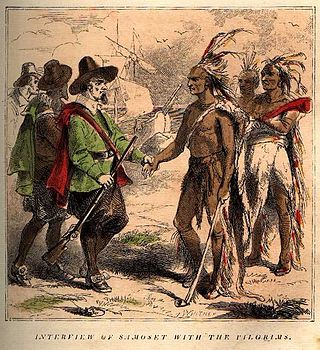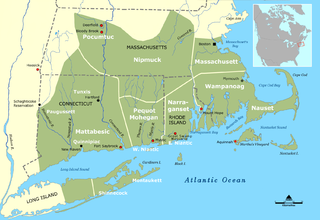
The Pilgrims, also known as the Pilgrim Fathers, were the English settlers who travelled to North America on the ship Mayflower and established the Plymouth Colony at what now is Plymouth, Massachusetts. John Smith had named this territory New Plymouth in 1620, sharing the name of the Pilgrims' final departure port of Plymouth, Devon. The Pilgrims' leadership came from religious congregations of Brownists or Separatists who had fled religious persecution in England for the tolerance of 17th-century Holland in the Netherlands.

The Mayflower Compact, originally titled Agreement Between the Settlers of New Plymouth, was the first governing document of Plymouth Colony. It was written by the men aboard the Mayflower, consisting of Separatist Puritans, adventurers, and tradesmen. Although the agreement contained a pledge of loyalty to the King, the Puritans and other Protestant Separatists were dissatisfied with the state of the Church of England, the limited extent of the English Reformation and reluctance of King James I of England to enforce further reform.

Plymouth Colony was the first permanent English colony in New England from 1620 and the third permanent English colony in America, after Newfoundland and the Jamestown Colony. It was settled by the passengers on the Mayflower at a location that had previously been surveyed and named by Captain John Smith. The settlement served as the capital of the colony and developed as the town of Plymouth, Massachusetts. At its height, Plymouth Colony occupied most of what is now the southeastern portion of Massachusetts. Many of the people and events surrounding Plymouth Colony have become part of American folklore, including the American tradition of Thanksgiving and the monument of Plymouth Rock.

Tisquantum, more commonly known as Squanto, was a member of the Patuxet tribe of Wampanoags, best known for being an early liaison between the Native American population in Southern New England and the Mayflower Pilgrims who made their settlement at the site of Tisquantum's former summer village, now Plymouth, Massachusetts. The Patuxet tribe had lived on the western coast of Cape Cod Bay, but were wiped out by an epidemic, traditionally assumed to be smallpox brought by previous European explorers; however, recent findings suggest that the disease was Leptospirosis, a bacterial infection transmitted to humans typically via "dirty water" or soil contaminated with the waste product of infected, often domestic animals.

Samoset was an Abenaki sagamore and the first American Indian to make contact with the Pilgrims of Plymouth Colony in New England. He startled the colonists on March 16, 1621 by walking into Plymouth Colony and greeting them in English, saying "Welcome, Englishmen."

Edward Winslow was a Separatist and New England political leader who traveled on the Mayflower in 1620. He was one of several senior leaders on the ship and also later at Plymouth Colony. Both Edward Winslow and his brother, Gilbert Winslow signed the Mayflower Compact. In Plymouth he served in a number of governmental positions such as assistant governor, three times was governor and also was the colony's agent in London. In early 1621 he had been one of several key leaders on whom Governor Bradford depended after the death of John Carver. He was the author of several important pamphlets, including Good Newes from New England and co-wrote with William Bradford the historic Mourt's Relation, which ends with an account of the First Thanksgiving and the abundance of the New World. In 1655 he died of fever while on an English naval expedition in the Caribbean against the Spanish.

Of Plymouth Plantation is a journal that was written over a period of years by William Bradford, the leader of the Plymouth Colony in Massachusetts. It is regarded as the most authoritative account of the Pilgrims and the early years of the colony which they founded.

Samuel Fuller was a passenger on the historic 1620 voyage of the Pilgrim ship Mayflower and became a respected church deacon and the physician for Plymouth Colony.
Hobbamock was a Pokanoket pniese who came to live with the Plymouth Colony settlers during the first year of their settlement in North America in 1620. His name was variously spelled in 17th century documents and today is generally simplified as Hobomok. He is known for his rivalry with Squanto, who lived with the settlers before him. He was greatly trusted by Myles Standish, the colony's military commander, and he joined with Standish in a military raid against the Massachuset. Hobomock was also greatly devoted to Massasoit, the sachem of the Pokanoket, who befriended the English settlers. Hobomok is often claimed to have been converted to Christianity, but what that meant to him is unclear.

Mayflower was an English sailing ship that transported a group of English families, known today as the Pilgrims, from England to the New World in 1620. After 10 weeks at sea, Mayflower, with 102 passengers and a crew of about 30, reached what is today the United States, dropping anchor near the tip of Cape Cod, Massachusetts, on November 21 [O.S. November 11], 1620.
George Morton or George Mourt was an English Puritan Separatist. He was the publisher of, and perhaps helped write, the first account in Great Britain of the founding of Plymouth Colony, called Mourt's Relation.

Capt. Nathaniel Morton was a Separatist settler of Plymouth Colony in Massachusetts, where he served for most of his life as Plymouth's secretary under his uncle, Governor William Bradford. Morton wrote an account of the settlement of the Colony, the first historical text published in the United States, and was first to publish a list of signers of the Mayflower Compact as well as an account of the first Thanksgiving.

William White was a passenger on the Mayflower. Accompanied by his wife Susanna, son Resolved and two servants, and joined by a son, Peregrine, on the way, he traveled in 1620 on the historic voyage. He was a signatory to the Mayflower Compact and perished early in the history of Plymouth Colony.

Resolved White was a passenger on the Pilgrim ship Mayflower. In 1620, he accompanied his parents, Pilgrims William and Susanna White, on the journey. He married Judith Vassall, daughter of William Vassall, a founder of the Massachusetts Bay Colony. Later in life White became a notable person of Plymouth Colony.
In the fall of 1621 the Fortune was the second English ship destined for Plymouth Colony in the New World, one year after the voyage of the Pilgrim ship Mayflower. Financed as the Mayflower was by Thomas Weston and others of the London-based Merchant Adventurers, Fortune was to transport thirty-five settlers to the colony on a ship that was much smaller than Mayflower. The Fortune required two months to prepare for the voyage and once underway, reached Cape Cod on 9 November 1621 and the colony itself in late November. The ship was unexpected by those in the Plymouth colony and although it brought useful settlers, many of whom were young men, it brought no supplies, further straining the limited food resources of the colony. The ship only stayed in the colony for about three weeks, returning to England in December loaded with valuable furs and other goods. But when nearing England, instead of heading to the English Channel, a navigation error caused the ship to sail southeast to the coast of France, where it was overtaken and seized by a French warship.
Also see: The ships Anne and Little James

The Mayflower Compact was an iconic document in the history of America, written and signed aboard the Mayflower on November 11, 1620, while anchored in Provincetown Harbor in Massachusetts. The Compact was originally drafted as an instrument to maintain unity and discipline in Plymouth Colony, but it has become one of the most historic documents in American history. It was published in London in Mourt's Relation in 1622, and the authors had added a preamble to clarify its meaning: "it was thought good there should be an association and agreement, that we should combine together in one body, and to submit to such government and governors as we should by common consent agree to make and choose."

Susanna (Jackson) White Winslow was a passenger on the Mayflower and successively wife of fellow Mayflower passengers William White and Edward Winslow.

John Goodman was a Pilgrim who traveled aboard the Mayflower in 1620 to Plymouth, Massachusetts..

Ninnimissinuok is an Indigenous term, to refer to Native Americans of southern New England region. These people include the Pawtucket, Massachusett, Nipmuck, Pokanoket, Niantic, Mohegan and Pequot, as well as the people of western Connecticut and Long Island. This term, a variation of the Narragansett word Ninnimissinûwock, which means roughly 'people', connotes familiarity and shared identity.














